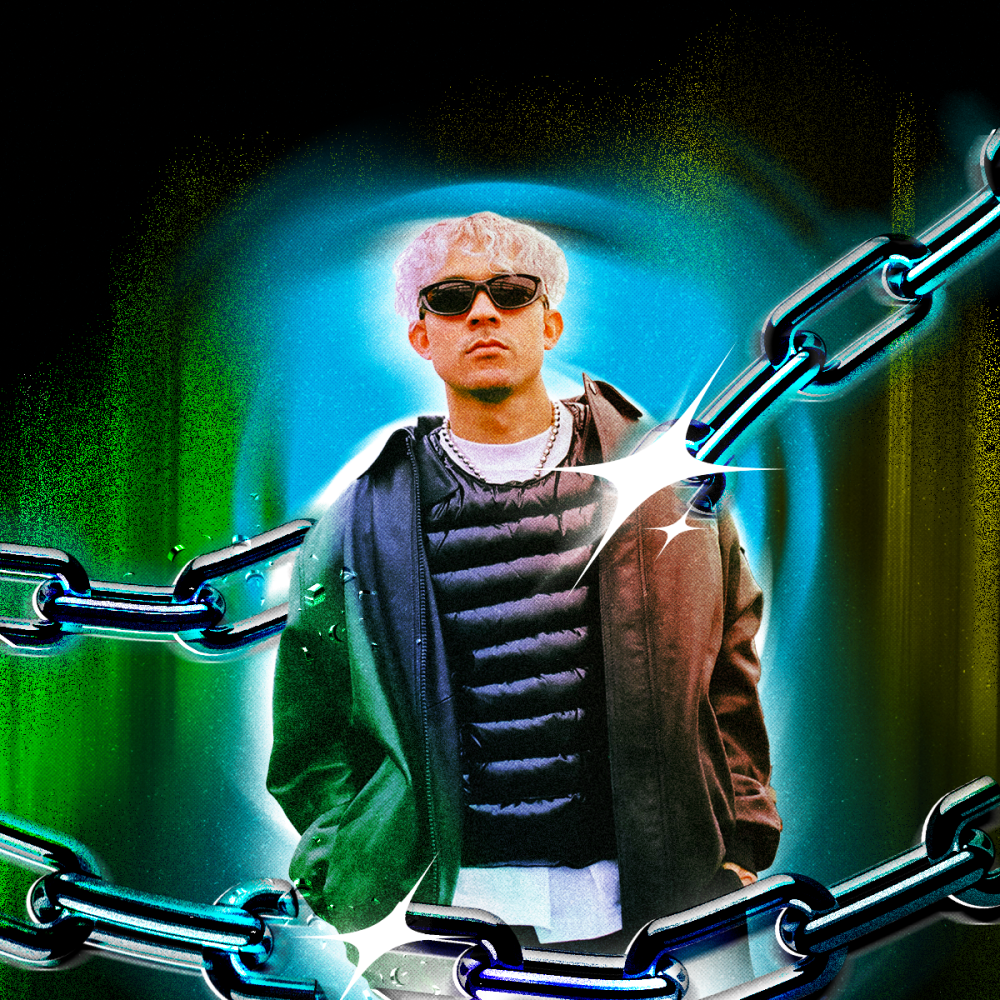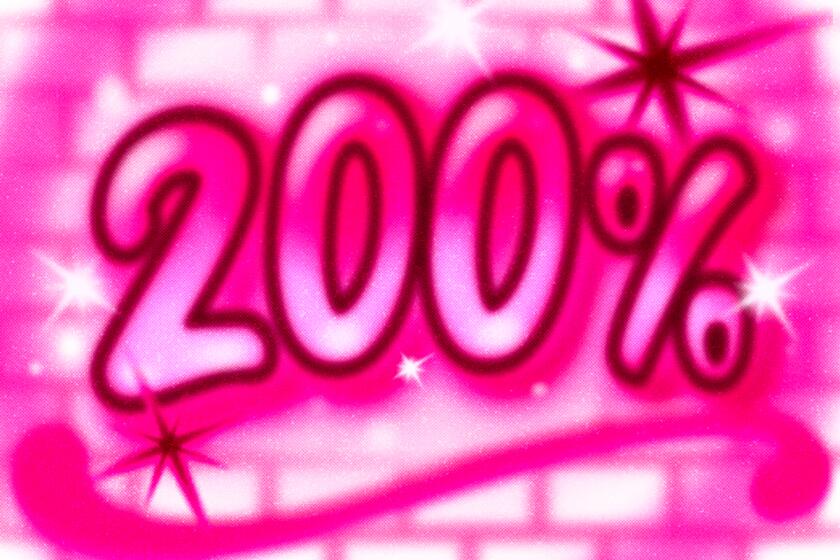
- Share via
Puerto Rican-Dominican producer Marco “Tainy” Masís, 33, has been alive for as long as people have been making reggaetón. And he’s not just grown up with the beloved Caribbean genre — which has romanced listeners well beyond the Spanish-speaking world — but, using elements of pop, alternative rock and EDM, the award-winning mix master has indelibly shaped it into an intrepid pop sound.
From his early works under the tutelage of legendary duo Luny Tunes to “Un Verano Sin Ti,” the Grammy-winning record he helped produce in 2022 with longtime collaborator Bad Bunny, Tainy’s fingerprints are all over reggaetón’s storied history, which is why he made the decision to spearhead his own debut album, “Data,” released on June 29.
“Seeing our genre not just evolving but exploding was motivating,” says Tainy, revealing his frosty purple haircut on a video call from his home studio in Miami. “But from the beginning, I was driven to change the way things were done.”
By stringing together one-of-a-kind boutique beats inspired by his travels — from his birthplace in Puerto Rico to the mountains of Japan — Tainy devised his very own global dream rave in “Data.” He also called back a number of his past collaborators to lend vocals, including Bad Bunny, Daddy Yankee, Rauw Alejandro and Julieta Venegas, as well as a brilliant cast of newcomers in Latin music. (EDM prodigies Skrillex and Four Tet also make appearances.)
An exploration of marketing terms like ‘200%’ and how that’s shaped our identity.
The premise, at first, seemed rather ambitious: Reggaetón itself has become a dense, busy ecosystem teeming with big sounds and bigger personalities, and its renaissance has resulted in a hyper-competitive playing field for artists and producers alike. When the genre’s most superlative ambassador, Bad Bunny, made history in 2020 as Spotify’s most-streamed artist of the year — then the next year, and the year after that — it made the charismatic superstar a hard act to follow.
Yet the sonic dimensions of “Data” show that reggaetón’s mainstream crossover moment is decidedly not the end-all-be-all for the genre. In this interview, Tainy discusses his trajectory in the music industry, how his love for Japanese anime informed “Data,” and what it means to lead a community of artists in forging new paths for reggaetón.
You’ve been producing professionally since you were 15 — your first track was for Luny Tunes’ 2005 classic compilation, “Mas Flow 2.” After all these years, what finally pushed you to do your own thing?
It’s always been a dream, ever since I first got the chance to work with Luny Tunes in Puerto Rico. That’s what I was seeing my idols do as a kid. And since then, I have evolved into a better producer. My craft is a lot better. At the same time, I have the right team behind me, and I have these relationships with the artists. I wouldn’t be able to do any of this alone. I feel like it’s the right moment for a record like this.
You packed in so many trap and reggaetón legends on this record! There’s Daddy Yankee — who’s supposedly retired but not really — then Bad Bunny, Chencho Corleone, Arcángel, J Balvin and Ozuna. These are all flashy names, but how did you choose the new talents to spotlight in this record?
I’m worried I’ll miss somebody! But I wanted to rep the new generation. Arca’s a producer I really respect, her approach to creating unique sounds was what I needed [on “Pasiempre”]. Omar Courtz is also one of these up-and-coming artists coming out of Puerto Rico. He’s got cool style, cool melodies. And I’ve always loved alternative music, so getting the Marías involved was important to me — and the contrast between María [Zardoya] and Young Miko’s voices made [“Mañana”] a standout.
Music festivals, night markets, and arts and culture venues are just a few of the fun things to check out this weekend in Los Angeles.
The gender inclusion on this record is noteworthy; it was only recently that people were sleeping on women in reggaetón! But you made sure to highlight Puerto Rican women like María Zardoya, Young Miko, Kany Garcia …
It’s got that woman power, but at the same time it’s got their amazing talent. For them to come from where I come from, I had to give them their spotlight.
You’ve been working with Bad Bunny since the 2018 song “I Like It,” and you most recently helped him shape “Un Verano Sin Ti,” which became a Boricua masterpiece. How has your relationship with him evolved since you started collaborating?
Beyond the numbers and his status, Benito is just somebody who gives me the space to be creative and to be myself. I think that’s the most special thing you can do for a producer, because at certain moments in my career, I would feel the pressure to replicate whatever I did that was successful, but I can only do so much. We’re like in the same generation — though I’m a little older than him — and our generation listens to a lot of different types of music. We’re interested in different kinds of art. So I think that helps us understand each other.
You two have always taken risks — and you got to the Grammys together because of it. Did you worry about making a reggaetón record that was too experimental?
I understand that for the majority of my career, 99% of what people have heard from me is reggaetón music, maybe with different twists or whatever — but that’s my base. I wanted to make something interesting for me, something progressive and fresh that showcases more of who I am and where I see myself going. Hopefully it ignites ideas or sparks new subgenres in music today!

Speaking of subgenres, let’s talk about reggaetón’s relationship with EDM. I think about how DJ Nelson was inspired by Chicago house, and how stars like Don Omar and Tony Dize experimented with electro-R&B elements in the 2000s. You crank up the disco, house and breakbeats throughout “Data.” What made you start working in the EDM space?
Growing up, dance and techno played a big part in my life: I heard it in movies, or on the radio in Puerto Rico. I knew that [if I wanted] to be a producer I had to dig into different genres and scenes in music: in Germany, Detroit, all the cool Latin house stuff in Miami. Seeing how Daft Punk performed live, as DJs, was really inspiring … seeing Skrillex come in and take over with dubstep … and how Aphex Twin and deadmau5 could dive in and evolve their sound for different spaces, it made me think about how reggaetón can be used with different styles and sounds.
A great example of this is “Volver,” your collaboration with rave enthusiast Rauw Alejandro and famed producers Skrillex and Four Tet. How did it come together?
I was out when I heard the Four Tet song “Lush.” It was random, I was just streaming music, and I let the platforms give me recommendations. I wasn’t familiar with his discography. But as soon as I heard it, I just drove straight to my house and started to sample it. It has a fast-paced BPM — I thought maybe with reggaetón, which has a slower BPM, it would make a really cool combination. Later on I got in the studio with Sonny [Skrillex] to show him this track, and give it this crescendo toward the end. I didn’t know that Four Tet was one of his good friends! So we FaceTimed with Four Tet and got his approval for the track. Then we finally met in person the second [week of] Coachella. I appreciated how the music brought us together.
In the album art and video for “Lo Siento Bb:/” we meet “Sena,” a pink-haired cyborg that you’ve programmed with songs in “Data,” which are uploaded into her hard drive. By the final track in the album, the upload is complete, and we hear her come alive. What sparked this concept?
I was inspired by one of my favorite movies, which is [1995‘s] “Ghost in the Shell.” I wanted to have a version of that [cyborg] where music gives her life. Music helps people have a great time, or a good cry. Music shapes who we are sometimes. So by giving a cyborg music, maybe it can help them feel what we feel. I’m currently trying to figure out how to do a live concert with Sena and let the audience follow her journey.

You can tell me if I’m out in left field, but I think about why Latinos love Japanese anime ... especially the postapocalyptic stories we grew up with, like “Akira,” or “Neon Genesis Evangelion.” We see characters picking up the pieces and reinventing themselves after disaster, or nuclear war. It feels like a lot of us grow up with a survival instinct that comes after hardship, which makes for creativity and innovation. What drew you to using anime in your work?
Right — I didn’t think about it then, but [those were] themes that I only understood more when I grew up. Series like “Evangelion” are still very influential to me because of the story of a young kid dealing with such big issues was so impactful. But also, before I started making music, I loved to draw. I feel inspired by Japanese artists’ imagination, their strict attention to detail and their precision. It’s a different art form than the one I work in, but it’s an approach I’m inspired by. That’s why I asked Hiromasa Ogura, the art director of “Ghost in the Shell,” to design my album art. It was such an honor to be able to have somebody respected in that industry and also to be able to give us a chance to do something that felt authentic.
Commentary: Pedro Pascal and Jenna Ortega signal shift in how Latinos are portrayed on screen
Jenna Ortega, Pedro Pascal and Aubrey Plaza are recognized for roles that present unique character arcs that dive deeper than most Latino representation on television.
Japan was a big inspiration for this. How did you spend your time there?
My initial idea was to work on the whole record over there! But it was tricky because not everybody’s flying to Japan to sit in the studio and create songs. Some people came to record in Miami, others sent me tracks digitally [while] I spent some time in Tokyo. We got to film the album visuals using the cityscape, and all the lights. Then I went to Kyoto because I wanted to experience the contrast — sitting down in a quiet house looking over the mountains for a couple of days, working by the gardens. I wanted to go to the source of my inspiration to take this project over the finish line.
What would you recommend to a young person who wants to be a producer and doesn’t know where to start?
You know, I never studied music — but I started from my household. I opened myself [up] and learned to appreciate what my family was playing, then what my friends at school were playing. Being open to learning something new is important. And there are so many programs you can download now — I started with Fruity Loops, then moved on to Ableton Live and Logic. I still go back to Fruity Loops sometimes, you know. … I’m a geeky producer, and it’s got sounds I like! Whatever helps you get your ideas across faster is what you stick to. It’s a special time to be a producer.
More to Read
The Latinx experience chronicled
Get the Latinx Files newsletter for stories that capture the multitudes within our communities.
You may occasionally receive promotional content from the Los Angeles Times.











